Physical activity and exercise encompass all forms of movement, from walking and cycling to playing sports and doing household chores. Even with perfect nutrition, your body will lose muscle and fitness if you’re not active or are confined to bed rest.
Regular exercise plays a vital role in preventing and managing diseases like heart disease, diabetes, and certain cancers. It also helps keep a healthy weight, boosts mental well-being, and improves overall quality of life.
Despite the many benefits, most U.S. adults don’t meet the recommended physical activity guidelines, even though many invest in gym memberships, fitness apps, and personal trainers.
Physical inactivity has a significant impact on our health, contributing to around 16% of deaths in the U.S. each year. Regular exercise not only helps us live longer, but the fitter we are, the better our bodies become at fighting many diseases.
The eye-opening exercise statistics below are here to inspire you to prioritize your health and well-being.

Global Exercise Statistics
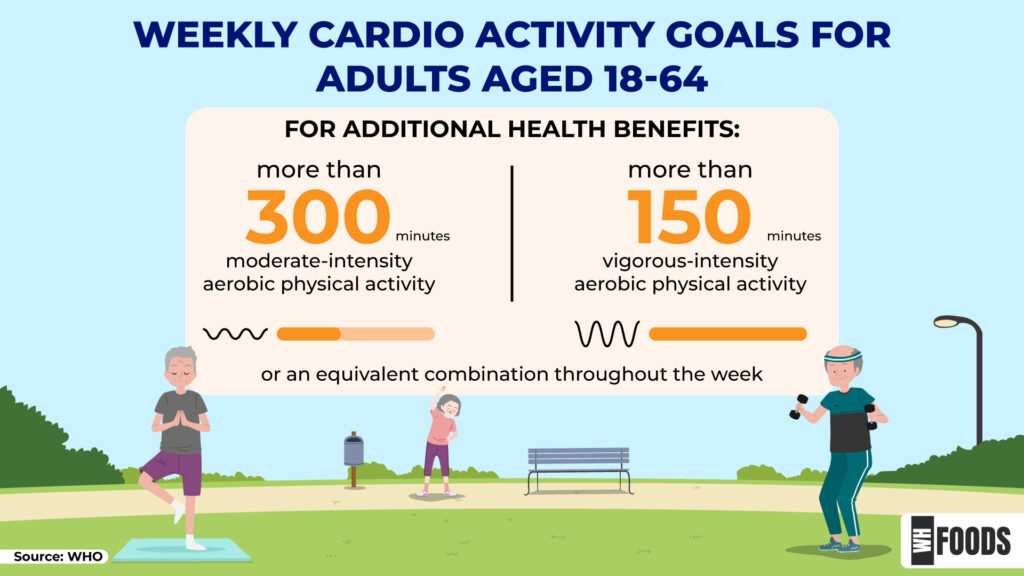
- For overall health and well-being, the WHO suggests that adults aged 18-64 should engage in 150-300 minutes of moderate-intensity aerobic activity or 75-150 minutes of vigorous-intensity aerobic exercise each week. Any amount of physical activity is beneficial, and the more you do, the better the results. (1)
- One in four (31%) adults and four in five (80%) adolescents fail to meet the recommended physical activity levels. This marks a 5 percentage point increase from 2010 to 2022. If this trend continues, the percentage of adults not meeting recommended physical activity levels could reach 35% by 2030. (2)
- Globally, physical inactivity remains more prevalent among women than men, with inactivity rates at 34% for women and 29% for men. In some countries, this gap is as large as 20 percentage points. Additionally, people over 60 are generally less active than younger adults, highlighting the need to encourage physical activity among older adults. (3)
Exercise Statistics in the U.S
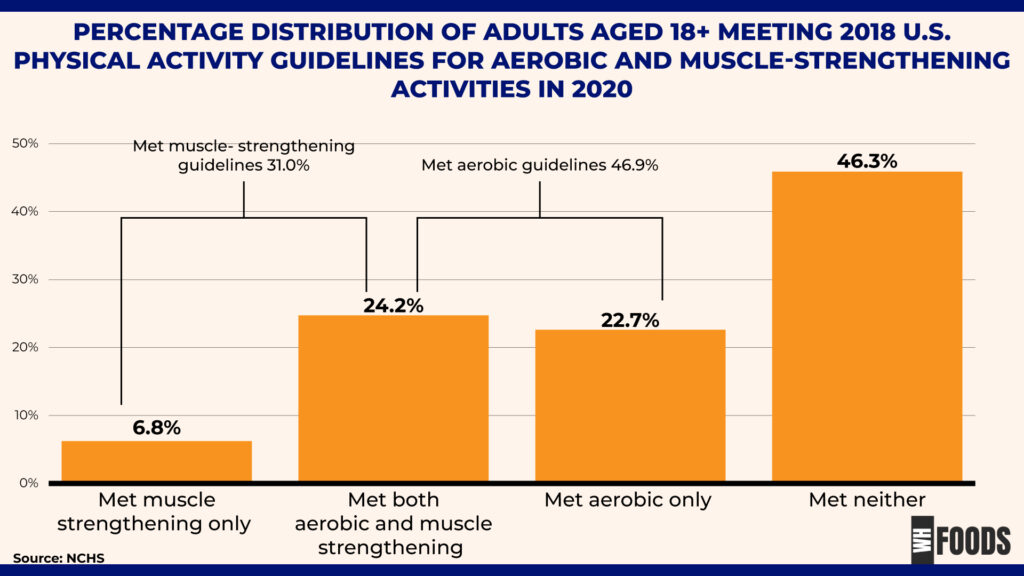
- Among adults aged 18 and over, 24.2% met the guidelines for both aerobic and muscle-strengthening activities, while 22.7% met only the aerobic activity guidelines. Additionally, 6.8% met only the muscle-strengthening guidelines, and 46.3% did not meet the guidelines for either type of activity. (4)
- Among all adults, 46.9% met the guidelines for aerobic activity, regardless of whether they met the muscle-strengthening guidelines. (4)
- The percentage of adults meeting both physical activity guidelines was higher among men (28.3%) compared to women (20.4%). Additionally, this percentage decreased with age for both men and women. (4)
- In 2022, 19% of people felt too intimidated to use a fitness studio. Despite the growing awareness of the benefits of fitness, many people still face barriers to getting started. High costs, concerns about cleanliness, and feelings of intimidation at gyms are some of the main reasons why consumers avoid these spaces. (5)
- Overall, combined Center for Disease Control and Prevention data from 2017 to 2020 indicate a physical inactivity prevalence of 25.3%. This means that they didn’t participate in activities like walking for exercise, running, or gardening outside of work. The prevalence of physical inactivity varies by location and race/ethnicity. (6)
- Regionally, the South had the highest prevalence of physical inactivity at 27.5%, followed by the Midwest at 25.2%, the Northeast at 24.7%, and the West at 21.0%. Colorado had the lowest prevalence of inactivity outside of work at 17.7%, while Puerto Rico had the highest at 49.4%. (6)
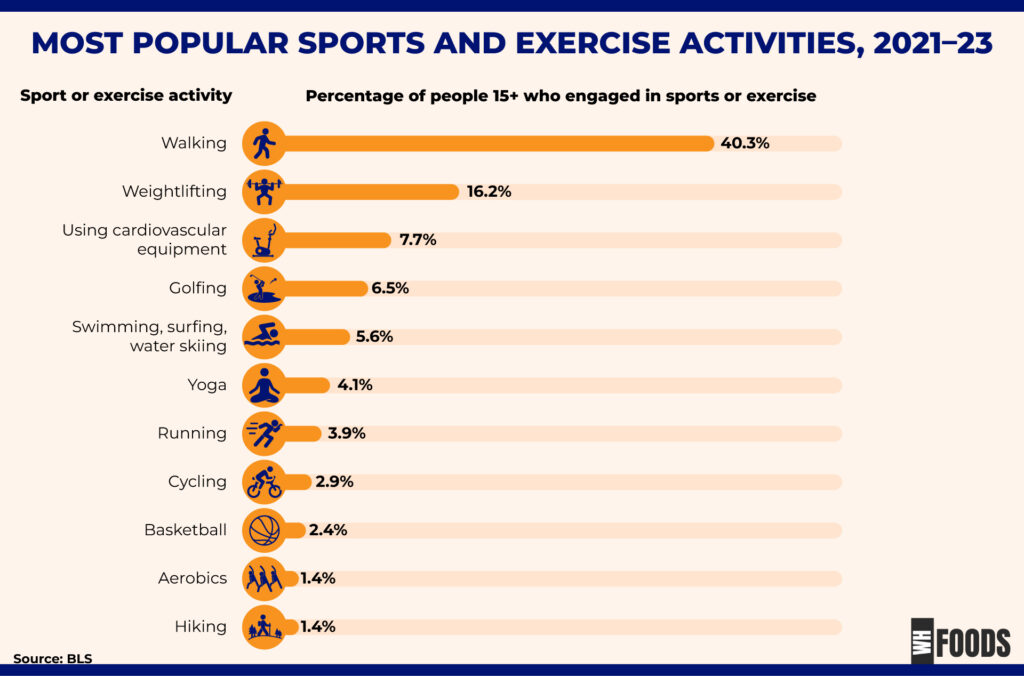
- Between 2021 and 2023, walking was the most popular form of exercise among people aged 15 and older in the United States. On an average day, 40.3% of those who participated in sports or exercise chose walking as their activity. (7)
- Another popular choice in the United States was weightlifting, one of the original nine sports featured in the first Olympic Games. On an average day, 16.2% of those who engaged in sports or exercise participated in weightlifting. (7)
Average Daily Exercise Participation In the U.S., 2010-2023
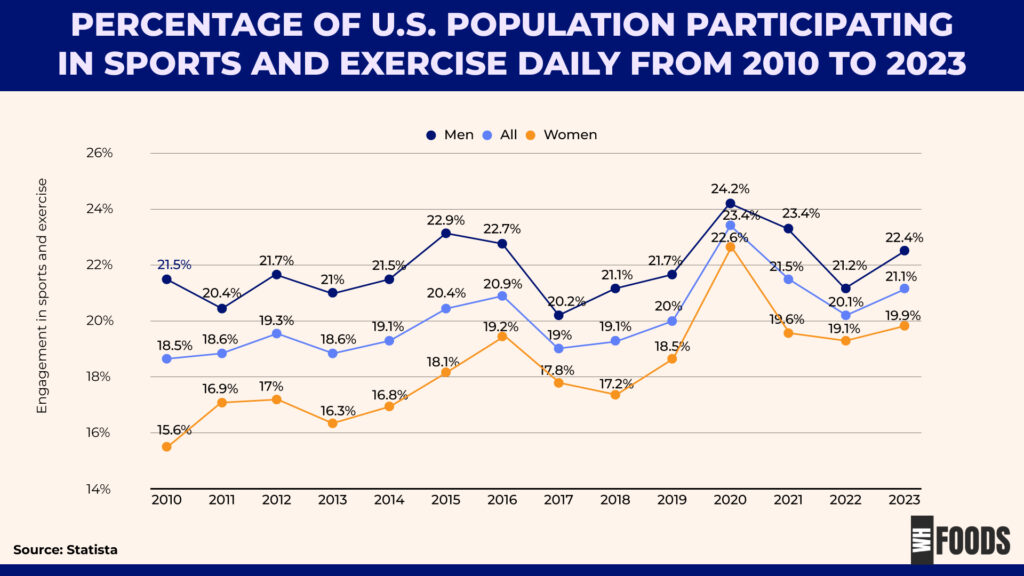
There is a significant difference in how different genders engage in daily sporting activities. Factors like socioeconomic status, age, disability, ethnicity, geography, personal interests, and societal expectations also play a role in shaping participation. These barriers can limit individuals’ access to and opportunities for sports, preventing equal involvement across all groups.
- In 2023, 22.4% of men in the U.S. participated in daily sports, exercise, and recreational activities, compared to 19.9% of women. (25)
Exercise Statistics in U.S. Cities
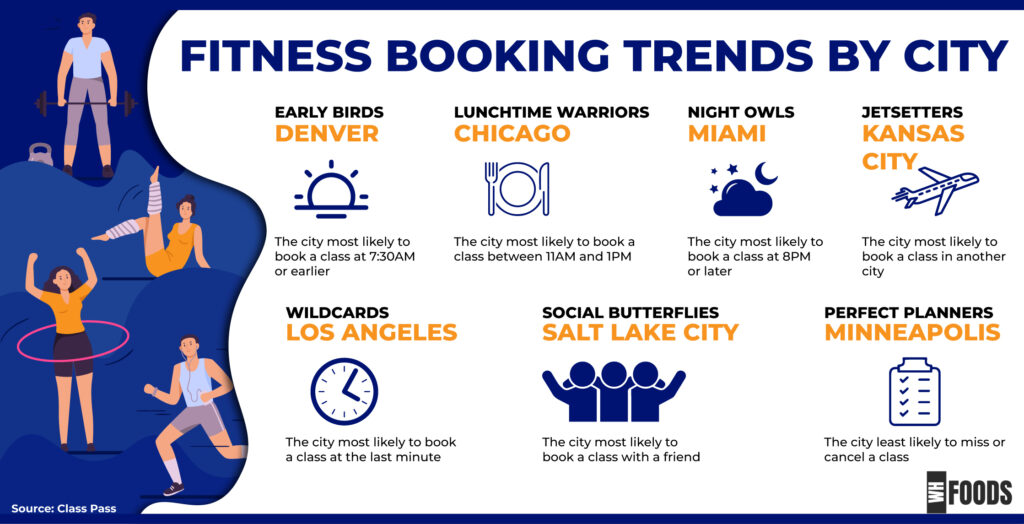
- Denver residents were most likely to take fitness classes at 7:30 a.m. or earlier. This suggests a strong preference for early workouts, likely due to factors such as fitting exercise into a busy schedule, taking advantage of the cooler morning temperatures, or simply prioritizing physical activity as a way to start the day energized. (8)
- Users in Chicago are most likely to book fitness classes between 11 a.m. and 1 p.m. This trend suggests that many Chicago residents prefer to exercise around midday, possibly taking advantage of their lunch breaks or using this time as a convenient mid-day break to stay active. (8)
- Miami residents are most likely to book fitness classes at 8 p.m. or later, indicating a preference for evening workouts, perhaps after work or other daily commitments. (8)
- Kansas City residents are most likely to reserve fitness classes in other cities. This trend might indicate that they travel frequently and prioritize staying physically active even when away from home. It could also suggest that they seek out specialized fitness experiences or classes not available locally. (8)
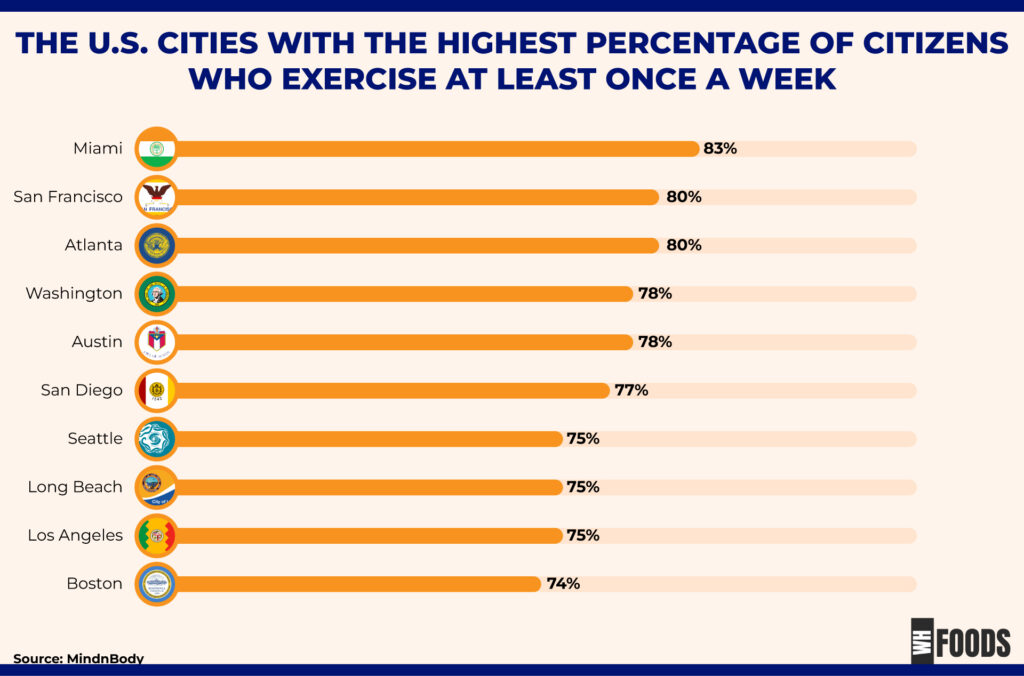
- Miami leads the way, with 83% of its residents working out at least once a week. The city also boasts the highest percentage of people aged 18-65 who exercise three or more times per week. Additionally, Miami residents invest the most in their fitness, spending on average about twice as much as the typical American. (9)
U.S. Exercise Statistics by Age Group
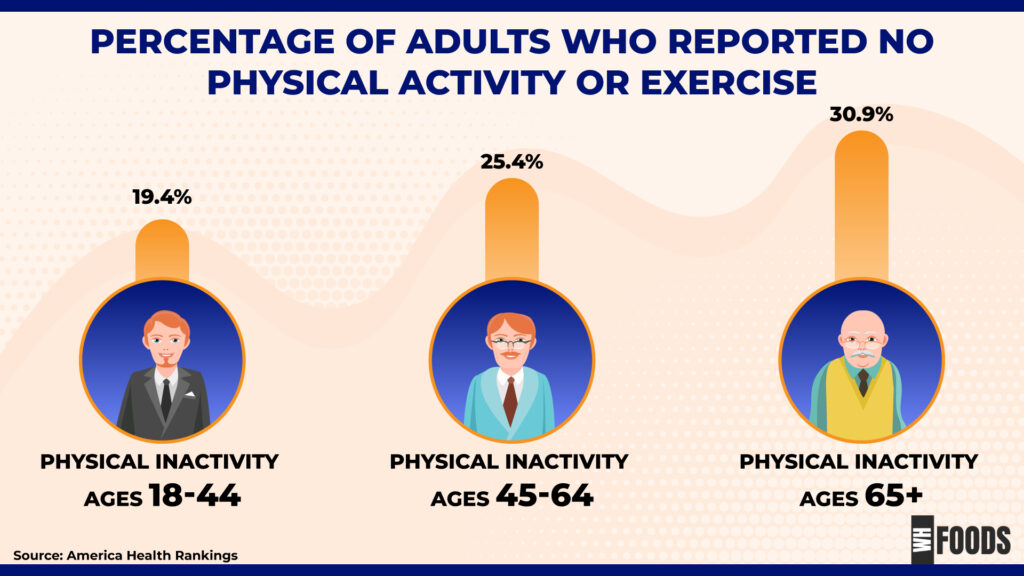
- 19.4% of adults aged 18-44 reported not engaging in any physical activity or exercise beyond their regular job in the past 30 days. (10)
- 23.4% of adults reported not engaging in any physical activity or exercise outside of their regular job in the past 30 days. Many adults spend a significant amount of their time sitting, even though regular physical activity offers numerous benefits. The costs linked to physical inactivity contribute to over 11% of total healthcare expenses. (10)
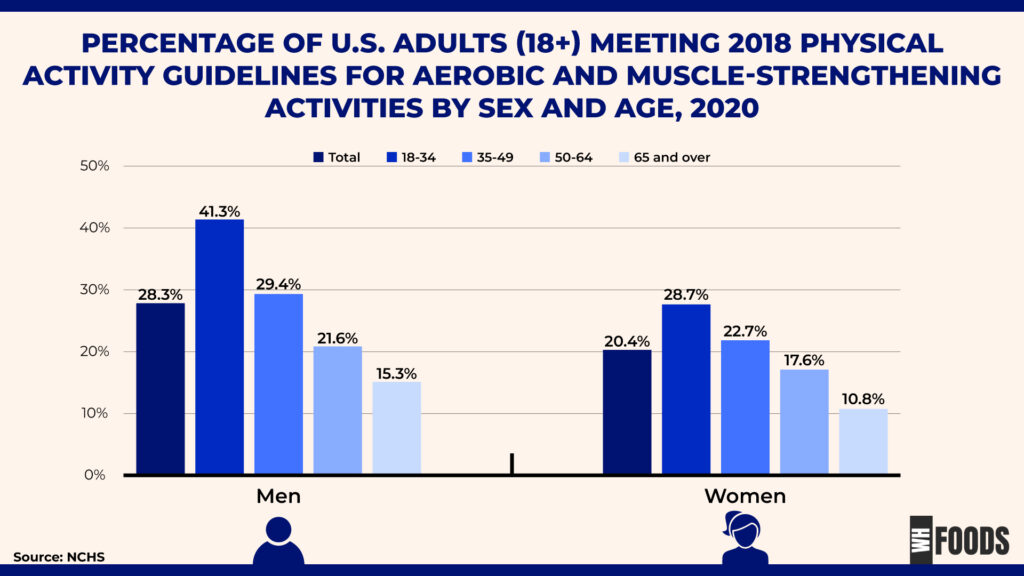
- The percentage of men meeting physical activity guidelines declines with age: 41.3% of men aged 18–34 meet the guidelines, dropping to 29.4% for those aged 35–49, 21.6% for those aged 50–64, and just 15.3% for men 65 and older. Across all age groups, men are more likely than women to meet exercise guidelines. (4)
U.S. Exercise Statistics by Race and Ethnicity
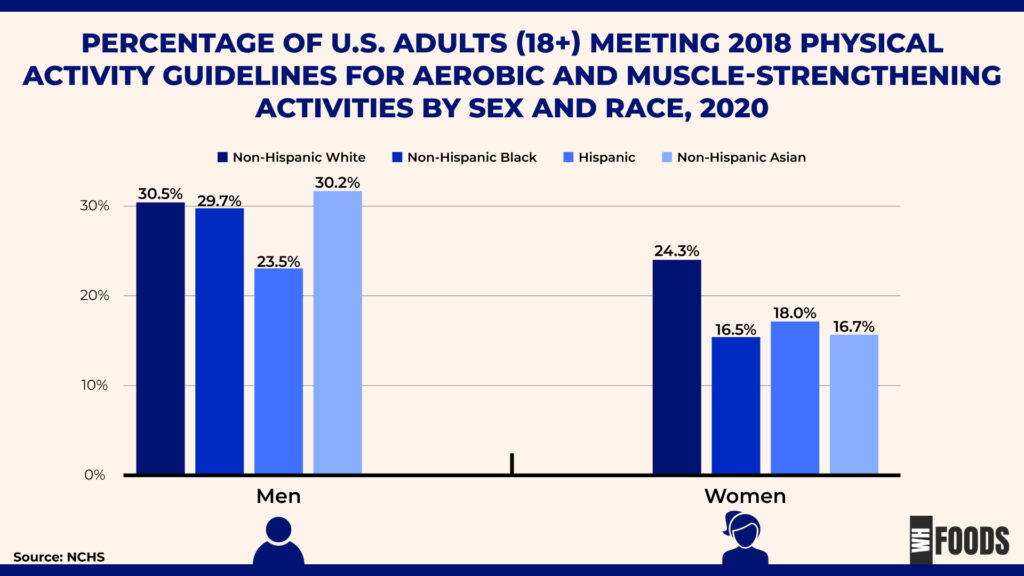
- Hispanic men are less likely to meet physical activity guidelines, with only 23.5% reaching the recommended levels, compared to higher percentages among non-Hispanic White (30.5%), Asian (30.2%), and Black (29.7%) men. This disparity highlights the need for targeted interventions and programs that address cultural, social, and economic barriers to physical activity within the Hispanic community, promoting more equitable health outcomes. (4)
- Non-Hispanic White women are more likely to meet physical activity guidelines, with 24.3% achieving the recommended levels. In contrast, Hispanic, Asian, and Black women have lower rates, with only 18.0%, 16.7%, and 16.5%, respectively, meeting these guidelines. (4)
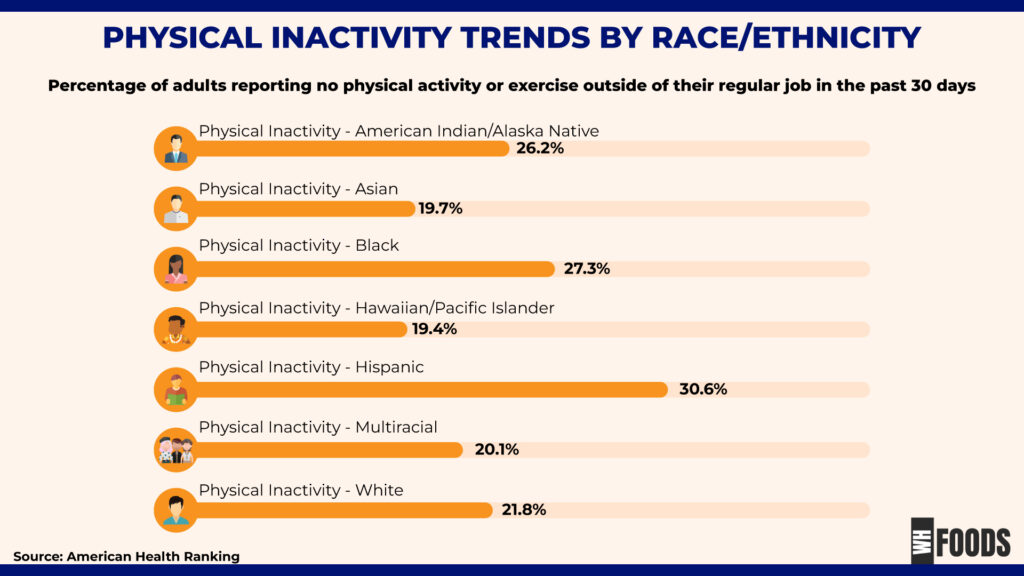
- 26.2% of American Indian/Alaska Native adults reported doing no physical activity or exercise outside of their regular job (10)
Civilian Daily Leisure and Sports Activities, 2023
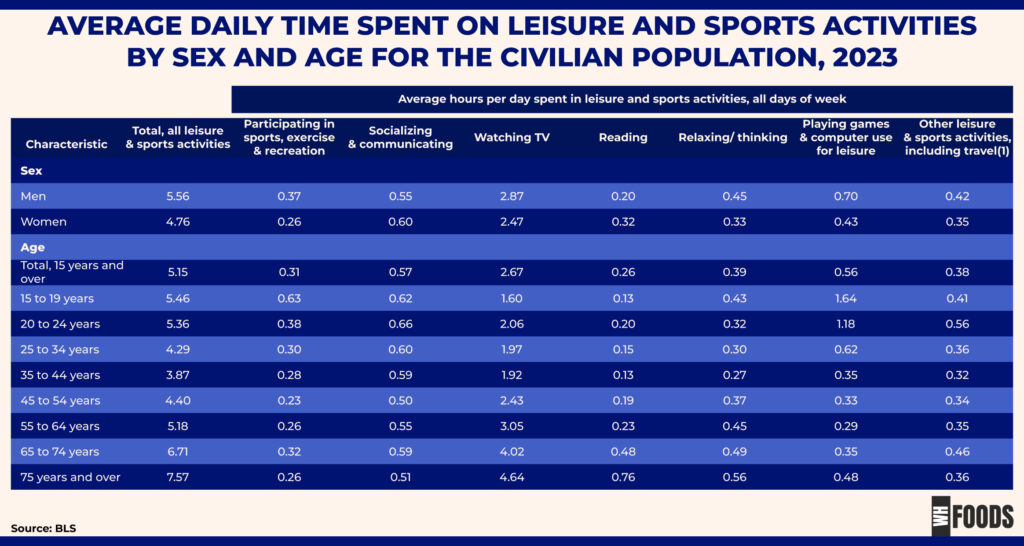
- In 2023, civilian daily leisure and sports activities reflect shifting trends in how people spend their free time. From engaging in physical activities to enjoying various forms of entertainment, these daily habits offer insights into the evolving priorities and lifestyles of individuals across different demographics.
- In 2023, men averaged 5.56 hours per day on sports and leisure, while women averaged 4.76 hours daily. (26)
- Total (15 years and over) spend an average of 5.15 hours per day on leisure and sports activities. (26)
Fitness Class Statistics
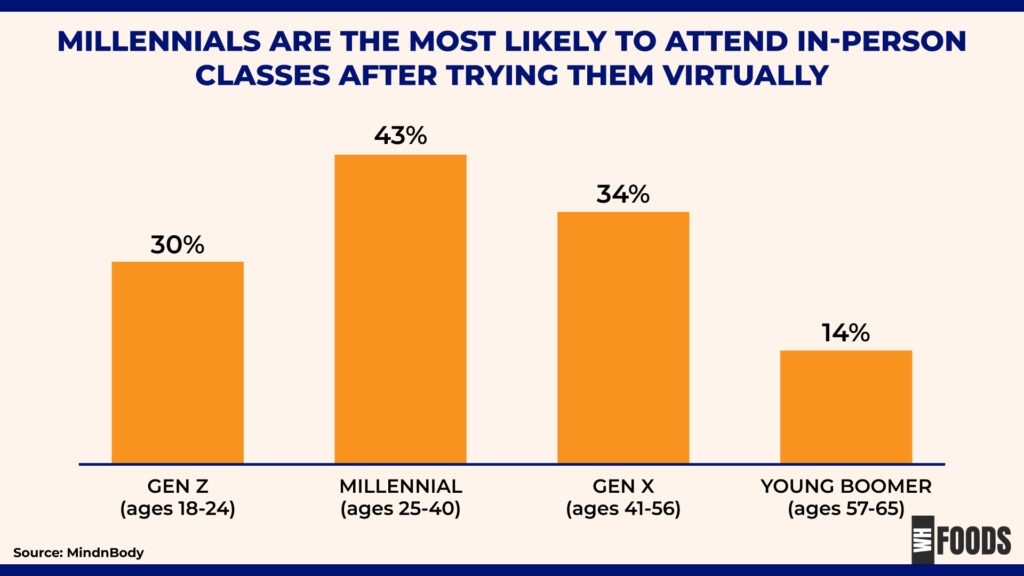
- 35% of Americans began attending in-person fitness classes they found through virtual fitness. Virtual workouts continue to be an effective tool for attracting and retaining members. (5)
- 43% of millennials (25-40) prefer in-person classes discovered virtually, followed by 30% of Gen Z (18-24) and 34% of Gen X. While in-person fitness has made a comeback, many Americans are still turning to virtual workouts. For a lot of people, these online sessions are just an extension of the fitness brand they already know and engage with. (5)
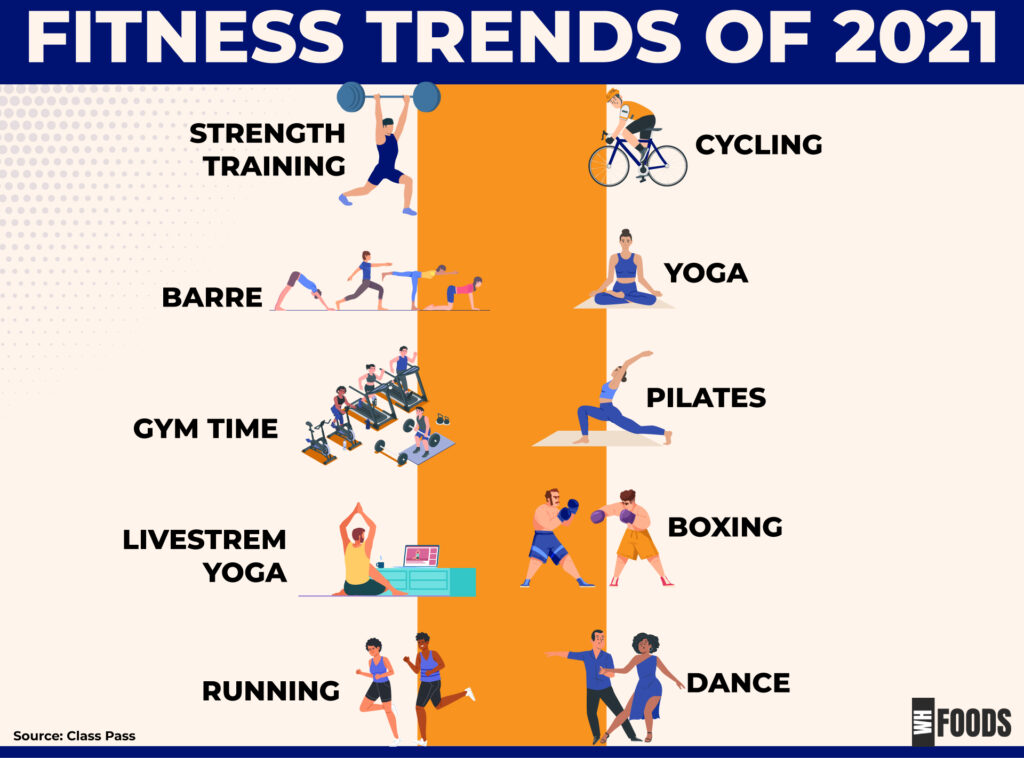
- The five most popular workouts of 2021 are strength training, yoga, spin classes, Pilates, and barre classes. Other top-booked fitness classes and workouts include boxing, general gym time, running classes, livestream yoga, and dance classes. Notably, for the first time, dance classes have broken into the top 10 most popular fitness classes booked. After spending a year on Zoom calls, it’s clear that people are eager to get moving and find positive outlets for self-expression. (11)
- Since January 2021, fitness reservations have increased by 329%. This sharp increase highlights the growing importance of structured workouts in people’s lives, driven by a desire to maintain health, reconnect with fitness communities, and regain the sense of normalcy that regular exercise provides. (11)
- According to the same ClassPass survey, the type of workout someone chooses often correlates with their emotional state. On stressful days, 60% of people gravitate toward high-energy workouts like boxing or HIIT, which can help release pent-up energy and stress. In contrast, 40% prefer calming and restorative exercises such as yoga, which can soothe the mind and body. (11)
- Lunchtime workouts, which saw a rise in popularity during 2020, continue to be a favored option for those working from home. Nearly 15% of people who work from home choose to use their lunch break for exercise, in contrast to just 4% of professionals who opt for a midday workout when they’re in the office. (11)
- In 2021, Tuesday was the most popular day for workouts, while Sunday was the most common rest day. (11)
- On days when people commute, the most popular time to exercise is at 5:30 p.m., with 57% of people likely to stop by fitness studios on their way home from work. Many individuals integrate their workout routines into their post-workday commute, making the most of their time after leaving the office before heading home. (11)
- People are 45% more likely to stick with a new workout routine if they take a class with a friend during their first month on ClassPass. Additionally, individuals who regularly work out with friends are 63% more likely to maintain their routine for 12 months or longer. (11)
Statistics on Cardio Exercise
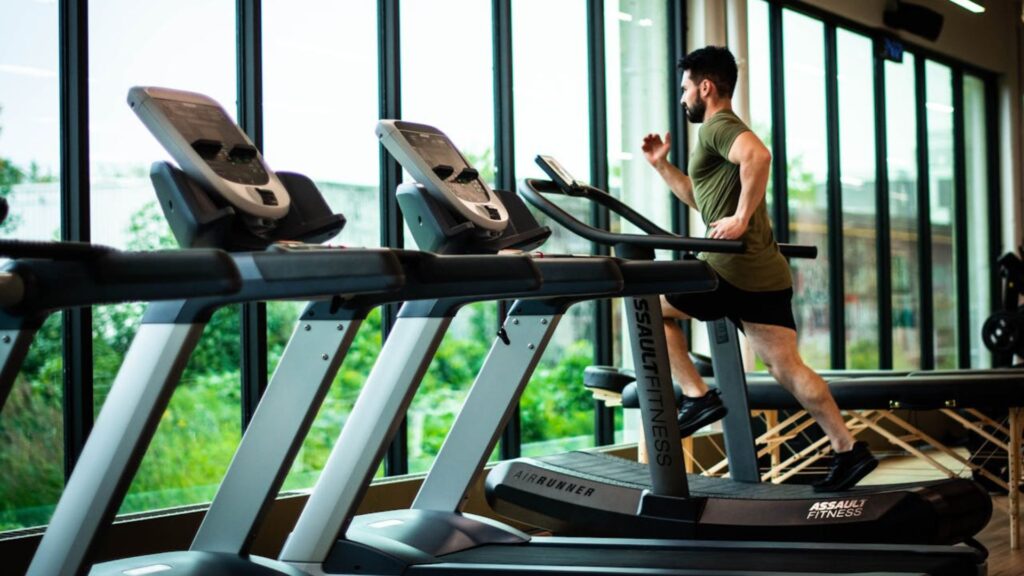
- RunSignup estimates that the 9,374,018 registrants on their platform in 2023 represent approximately 40% of the U.S. race registration market. (12)
- Approximately 51.2% of adults reported visiting a swimming pool in the past six months, while 44.5% spent time near other bodies of water, such as oceans, lakes, or rivers. This data highlights the popularity of aquatic activities among adults, whether for recreation, exercise, or leisure, reflecting a widespread engagement with water-related environments. (13)
- Approximately 17% of adults reported spending seven or more days at a swimming pool in the past six months. (13)
- According to the latest data from the U.S. Census Bureau’s American Community Survey, an estimated 731,272 Americans used bicycles as their primary mode of transportation to work in 2022. This figure represents an increase from 2021 but is still down by nearly 75,000 from pre-pandemic levels and by 175,000 from the peak year of 2014. (14)
Strength-Training Statistics

- Adherence was low everywhere, with just 52% meeting aerobic physical activity and 35% meeting muscle-strengthening activity guidelines across all regions. (15)
- The health and fitness industry is shifting back to basics, with strength training using free weights ranked as the #2 trend and bodyweight training as the #3 trend for 2023. This return to basics reflects a growing focus on accessible and effective workout methods that can be adapted to various fitness levels and goals. (16)
- The record for the most push-ups completed in one hour by a male is 3,378. This impressive achievement was made by Pop Laurentiu in London, UK, on June 30, 2023. (17)
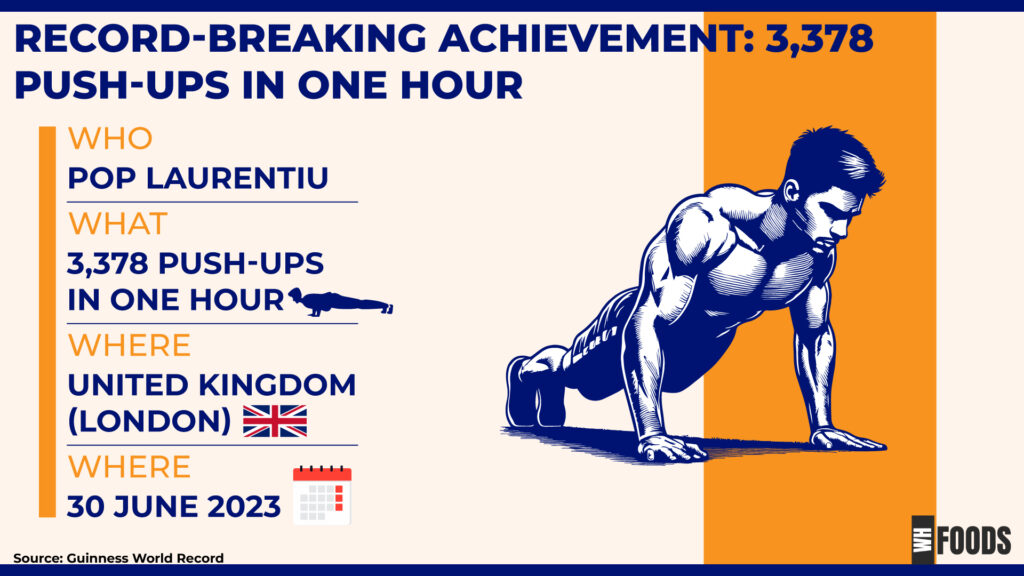
- Mike Carroll set a record in Canberra, Australia, by lifting 4,080 kg (8,994.86 lbs) in a two-minute bench press. Mike, a full-time nurse, dedicated four months to rigorous training in preparation for his attempt. His regimen included bench pressing three times a week, complemented by two additional days focused on strengthening supporting muscles. (18)
- The record for the most pull-ups in one minute is an impressive 77, achieved by Adam Sandel in Boston, Massachusetts, on April 20, 2024. Adam has held this title four times since 2015, making this one of the most challenging and competitive records to achieve. (19)
Statistics on the Benefits of Exercise
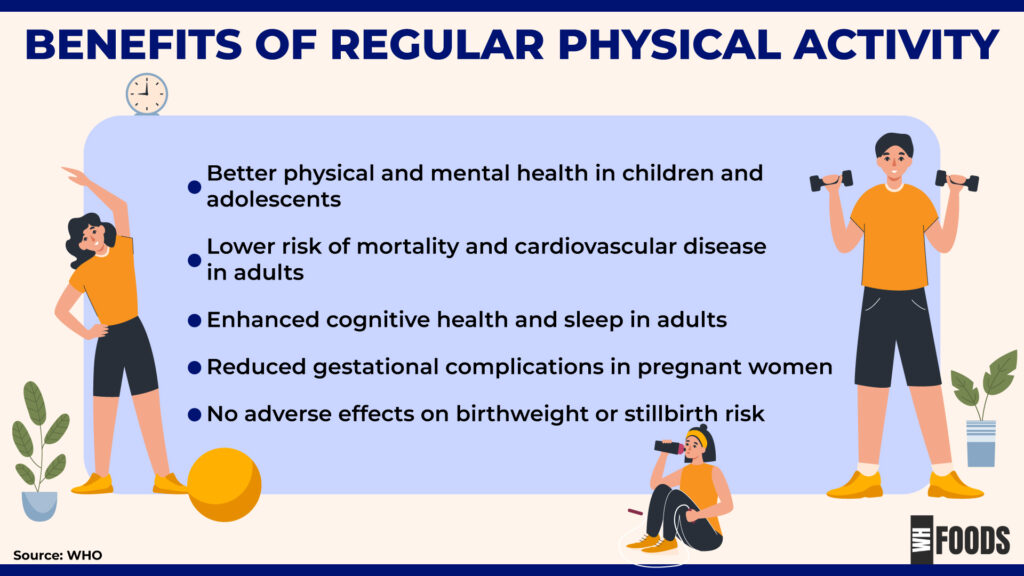
- A 20-minute brisk walk 5 times a week significantly lowers the risk of depression. (20)
- Extensive evidence shows the health benefits of exercise, including delaying the onset of around 40 chronic conditions and diseases. Regular physical activity contributes to improved cardiovascular health, better metabolic function, enhanced immune response, and reduced risk of conditions such as heart disease, diabetes, certain cancers, and neurodegenerative diseases. (21)
- Individuals who are insufficiently active have a 20% to 30% higher risk of death compared to those who are sufficiently active. (2)
Statistics on Exercise and Stress

- According to a recent online poll conducted by the Anxiety and Depression Association of America (ADAA), about 14% of people use regular exercise as a way to cope with stress. Among those who exercise, walking is the most popular choice, preferred by 29%, followed by running at 20% and yoga at 11%. (22)
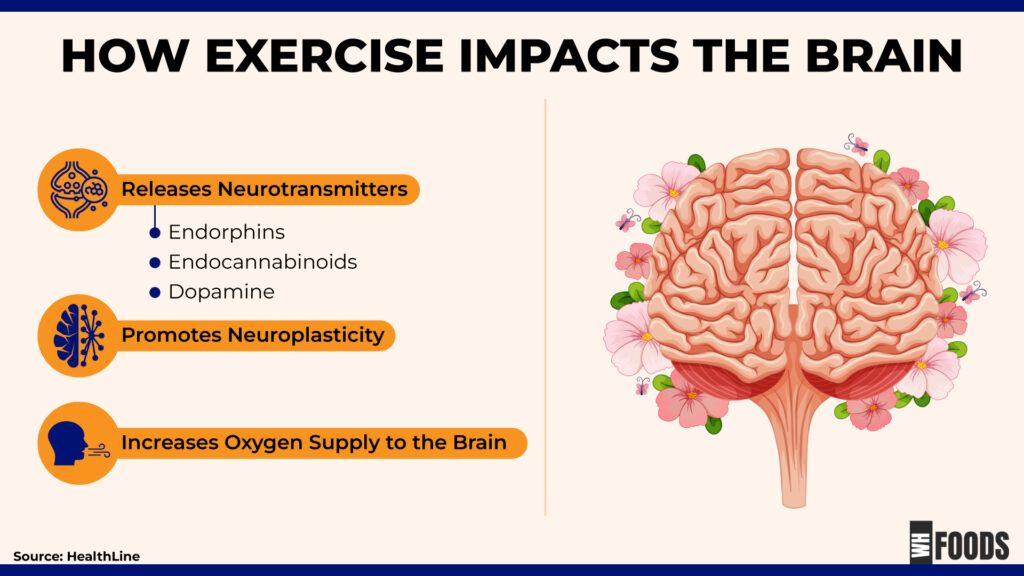
- People who engage in more than four hours of recreational exercise per week have a 19% lower risk of developing high blood pressure compared to those who exercise for less than one hour per week. These findings suggest that increasing the amount of physical activity during leisure time can significantly protect against the onset of high blood pressure. (23)
- Exercising one to three hours weekly lowers high blood pressure risk by 11% compared to less than an hour of exercise. (23)
Statistics on Exercise and Life Expectancy
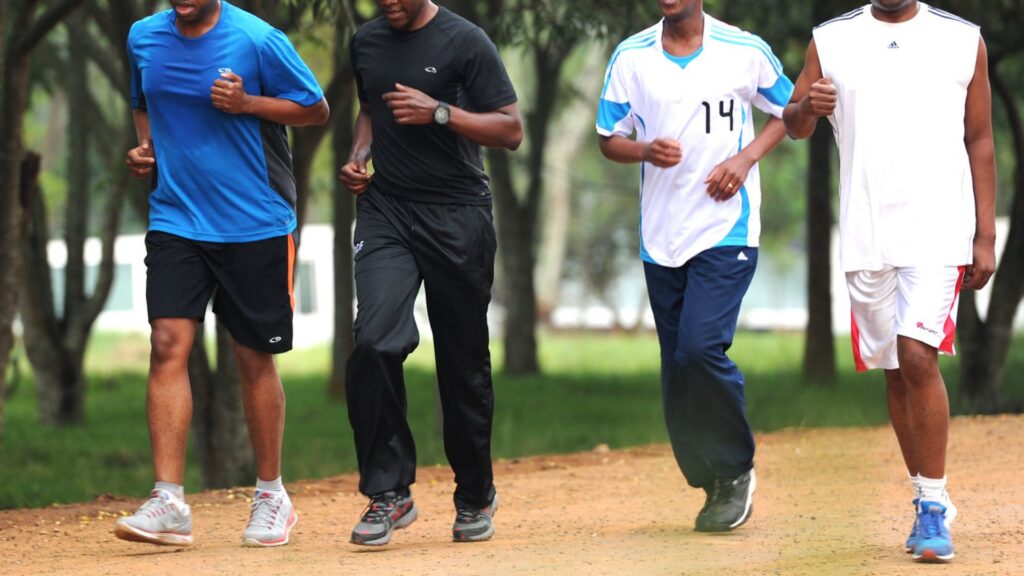
- Participants in a study conducted by the American Medical Association (AMA) who engaged in two to four times the recommended amount of moderate physical activity experienced significant health benefits. They had a 26% to 31% lower risk of all-cause mortality and a 28% to 38% lower risk of cardiovascular disease mortality. Additionally, there was a 25% to 27% reduction in the risk of non-cardiovascular disease mortality. (24)
Number of Health Clubs in the U.S. by State In 2019
A common and effective way to stay in shape is by regularly visiting a health club or gym. These facilities offer various equipment and classes to support fitness goals.
- In 2019, the United States had a total of 41,370 health clubs. California had the highest number with 5,123 gyms, while Wyoming had the fewest, with just 81 health clubs. (27)
Final Thought
Regular exercise is essential for maintaining optimal heart health and overall well-being. Engaging in vigorous intensity physical activity and strength training exercises not only helps control weight and reduce body fat but also significantly lowers the risk of heart disease and other chronic conditions. The Department of Health and Human Services emphasizes the importance of meeting physical activity guidelines to prevent becoming physically inactive, which is a major risk factor for heart disease. Additionally, combining regular exercise with a healthy diet is crucial for achieving and maintaining exercise goals.
With more Americans participating in physical activities, the benefits become increasingly clear. By staying active, individuals not only improve their heart health but also enhance their quality of life. CDC data highlights the importance of physical activity in preventing and managing chronic diseases. Setting and achieving exercise goals can inspire others to take control of their health, proving that the key to longevity and healthy life lies in consistent physical activity and mindful living.
Sources
- WHO GUIDELINES ON PHYSICAL ACTIVITY AND SEDENTARY BEHAVIOUR
- WHO: Physical activity
- Nearly 1.8 billion adults at risk of disease from not doing enough physical activity
- Physical Activity Among Adults Aged 18 and Over: United States, 2020
- 2022 Wellness Index – Fitness Report
- Adult Physical Inactivity Outside of Work
- Watching the Olympics? Many common sports and exercise activities are part of the competition
- ClassPass 2019 Fitness Trends
- 10 Most Active Cities in America in 2022
- America’s Health Rankings – 2023 Annual Report
- ClassPass Beauty and Fitness Trends: What To Expect In 2022
- RaceTrends Annual Industry Report 2023
- Vital Signs: Drowning Death Rates, Self-Reported Swimming Skill, Swimming Lesson Participation, and Recreational Water Exposure — United States, 2019–2023
- United States Census Bureau Data
- Prevalence of Meeting Aerobic, Muscle-Strengthening, and Combined Physical Activity Guidelines During Leisure Time Among Adults, by Rural-Urban Classification and Region — United States, 2020
- Worldwide Survey of Fitness Trends for 2023
- Most push ups in one hour (male)
- Video: Powerlifting champion beats challenging bench press record by lifting more than 4,000 kg
- Most pull ups in one minute (male)
- Physical Activity Dose and Depression in a Cohort of Older Adults in The Irish Longitudinal Study on Ageing
- Health Benefits of Exercise
- Physical Activity Reduces Stress
- Exercise Could Lower High Blood Pressure Risk
- Massive study uncovers how much exercise is needed to live longer
- Average percentage of the population engaged in sports, exercise, and recreation per day in the United States from 2010 to 2023
- BLS: Table 11A. Time spent in leisure and sports activities for the civilian population by selected characteristics, averages per day, 2023 annual averages
- Number of health clubs in the United States in 2019, by state







Write a comment
Your email address will not be published. All fields are required